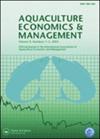Modeling the demand across three major protein sources: Focusing on seafood protein
IF 3.7
2区 经济学
Q1 AGRICULTURAL ECONOMICS & POLICY
引用次数: 0
Abstract
Abstract Despite recent dramatic growth in seafood consumption worldwide, knowledge about seafood demand is limited relative to other protein sources. We model demand across three major protein categories (i.e., terrestrial meat, seafood, and plant-based protein) in South Korea to fill the research gap. This study models a quadratic almost ideal demand system (QUAIDS) by utilizing household panel data. The study takes this one step further by modeling demand within four seafood categories (i.e., fish, cephalopods, shellfish, and crustaceans). Sociodemographic variables, including health-related factors, are incorporated into the demand models. Results indicate that seafood is in a complementary relationship with terrestrial meat while it is a substitute for plant-based protein. All four seafood categories are a substitute for each other. The results reveal that people who take their health seriously tend to consume more seafood, particularly fish. The results have economic and marketing implications for which strategies could be adopted to influence seafood consumption.对三种主要蛋白质来源的需求进行建模:重点关注海鲜蛋白质
摘要尽管最近全球海鲜消费量急剧增长,但与其他蛋白质来源相比,对海鲜需求的了解有限。我们对韩国三大蛋白质类别(即陆生肉、海鲜和植物蛋白)的需求进行了建模,以填补研究空白。本研究利用家用面板数据建立了二次型几乎理想需求系统(QUAIDS)的模型。该研究通过对四类海鲜(即鱼类、头足类、贝类和甲壳类动物)的需求进行建模,进一步推动了这一进程。社会经济变量,包括与健康相关的因素,被纳入需求模型。结果表明,海鲜与陆地肉类具有互补关系,而它是植物蛋白的替代品。所有四种海鲜都是相互替代的。研究结果表明,重视健康的人往往会吃更多的海鲜,尤其是鱼。研究结果具有经济和营销意义,可以采取哪些策略来影响海鲜消费。
本文章由计算机程序翻译,如有差异,请以英文原文为准。
求助全文
约1分钟内获得全文
求助全文
来源期刊

Aquaculture Economics & Management
FISHERIES-
CiteScore
7.30
自引率
17.90%
发文量
21
期刊介绍:
Aquaculture Economics and Management is a peer-reviewed, international journal which aims to encourage the application of economic analysis to the management, modeling, and planning of aquaculture in public and private sectors. The journal publishes original, high quality papers related to all aspects of aquaculture economics and management including aquaculture production and farm management, innovation and technology adoption, processing and distribution, marketing, consumer behavior and pricing, international trade, policy analysis, and the role of aquaculture in food security, livelihoods, and environmental management. Papers are peer reviewed and evaluated for their scientific merits and contributions.
 求助内容:
求助内容: 应助结果提醒方式:
应助结果提醒方式:


